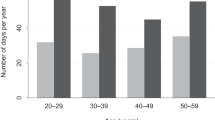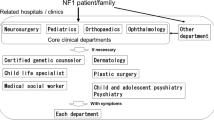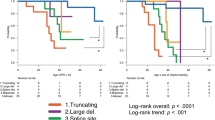Abstract
Individuals with neurofibromatosis 1 (NF1) may have problems in managing the transition between childhood and adulthood, such as forming a relationship or finding a partner. We aimed to determine the association between NF1 and forming and ending marital or cohabiting relationships by comparing a large Danish population of adults with NF1 with population comparisons. In this population-based cohort study, we compared a population of Danish adults who were hospitalized for or with complications to prior diagnosed NF1 (n = 787) with population comparisons matched on gender and birth year (n = 7787) through nationwide registries with annually updated information on marriage and cohabitation. Discrete-time survival models were used to estimate hazard ratios (HRs) and 95% confidence intervals (CIs) for the formation and termination of relationships, with adjustment for birth year, gender, and somatic and psychiatric comorbidities at entry. Individuals with NF1 were significantly less likely to form a relationship (HR = 0.65; 95% CI: 0.58–0.73), with the lowest association for individuals ≥33 years (HR 0.40; 95% CI: 0.25–0.63) and the highest for those aged 18–20 years (HR 0.82; 95% CI: 0.70–0.96). No significant difference was found for ending relationships (HR 1.00; 95% CI: 0.86–1.16). In conclusion, individuals who were hospitalized for NF1 are less likely to engage in marital or cohabiting relationships than population comparisons and are older when they form their first relationship. Once a relationship has been established, however, couples with a NF1-individual are not at greater risk of ending the relationship.
This is a preview of subscription content, access via your institution
Access options
Subscribe to this journal
Receive 12 print issues and online access
$259.00 per year
only $21.58 per issue
Buy this article
- Purchase on SpringerLink
- Instant access to full article PDF
Prices may be subject to local taxes which are calculated during checkout

Similar content being viewed by others
References
Stewart DR, Korf BR, Nathanson KL, Stevenson DA, Yohay K. Care of adults with neurofibromatosis type 1: a clinical practice resource of the American College of Medical Genetics and Genomics (ACMG). Genet Med. 2018;20:671–82.
Pride NA, Korgaonkar MS, Barton B, Payne JM, Vucic S, North KN. The genetic and neuroanatomical basis of social dysfunction: lessons from neurofibromatosis type 1. Hum Brain Mapp. 2014;35:2372–82.
Chisholm AK, Anderson VA, Pride NA, Malarbi S, North KN, Payne JM. Social function and autism spectrum disorder in children and adults with neurofibromatosis type 1: a systematic review and meta-analysis. Neuropsychol Rev. 2018;28:317–40.
Ferner RE. Neurofibromatosis 1 and neurofibromatosis 2: a twenty first century perspective. Lancet Neurol. 2007;6:340–51.
Pride NA, Crawford H, Payne JM, North KN. Social functioning in adults with neurofibromatosis type 1. Res Dev Disabil. 2013;34:3393–9.
Ejerskov C, Lasgaard M, Ostergaard JR. Teenagers and young adults with neurofibromatosis type 1 are more likely to experience loneliness than siblings without the illness. Acta Paediatr. 2015;104:604–9.
Ablon J. Gender response to neurofibromatosis 1. Soc Sci Med. 1996;42:99–109.
Rosnau K, Hashmi SS, Northrup H, Slopis J, Noblin S, Ashfaq M. Knowledge and self-esteem of individuals with neurofibromatosis type 1 (NF1). J Genet Couns. 2017;26:620–7.
Hummelvoll G, Antonsen KM. Young adults’ experience of living with neurofibromatosis type 1. J Genet Couns. 2013;22:188–99.
Wang DL, Smith KB, Esparza S, Leigh FA, Muzikansky A, Park ER, et al. Emotional functioning of patients with neurofibromatosis tumor suppressor syndrome. Genet Med. 2012;14:977–82.
Meier A, Allen G. Intimate relationship development during the transition to adulthood: differences by social class. New Dir Child Adolesc Dev. 2008;119:25–39.
Doser K, Kenborg L, Andersen EW, Bidstrup PE, Kroyer A, Hove H, et al. Educational delay and attainment in persons with neurofibromatosis 1 in Denmark. Eur J Hum Genet. 2019;27:857–68.
National Institutes of Health Consensus Development Conference Statement: neurofibromatosis. Bethesda MD, USA, July 13–15, 1987. Neurofibromatosis. 1988;1:172–8.
Lynge E, Sandegaard JL, Rebolj M. The Danish National Patient Register. Scand J Public Health 2011;39(7 Suppl):30–3.
Pedersen CB. The Danish Civil Registration System. Scand J Public Health 2011;39(7 Suppl):22–5.
StatisticsDenmark https://www.dst.dk/en/Statistik/dokumentation/documentationofstatistics/households--families-and-children; 2019.
Mors O, Perto GP, Mortensen PB. The Danish Psychiatric Central Research Register. Scand J Public Health 2011;39(7 Suppl):54–7.
Hosmer DW, Lemeshow S, May S. Applied Survival Analysis: Regression Modeling of Time-to-Event Data. Hoboken, New Jersey: John Wiley & Sons, Inc; 2000.
Garwood MM, Bernacki JM, Fine KM, Hainsworth KR, Davies WH, Klein-Tasman BP. Physical, cognitive, and psychosocial predictors of functional disability and health-related quality of life in adolescents with neurofibromatosis-1. Pain Res Treat. 2012;2012:975364.
Allen T, Willard VW, Anderson LM, Hardy KK, Bonner MJ. Social functioning and facial expression recognition in children with neurofibromatosis type 1. J Intellect Disabil Res. 2016;60:282–93.
Vassallo G, Mughal Z, Robinson L, Weisberg D, Roberts SA, Hupton E, et al. Perceived fatigue in children and young adults with neurofibromatosis type 1. J Paediatr Child Health. https://doi.org/10.1111/jpc.14764; 2020 [Epub ahead of print].
Smith KB, Wang DL, Plotkin SR, Park ER. Appearance concerns among women with neurofibromatosis: examining sexual/bodily and social self-consciousness. Psychooncology 2013;22:2711–9.
Crawford HA, Barton B, Wilson MJ, Berman Y, McKelvey-Martin VJ, Morrison PJ, et al. The impact of neurofibromatosis type 1 on the health and wellbeing of Australian adults. J Genet Couns. 2015;24:931–44.
Acknowledgements
The study was supported by a grant from the US Army Medical Research and Material Command (award number W81XWH-14-1-0054).
Author information
Authors and Affiliations
Corresponding author
Ethics declarations
Conflict of interest
The authors declare that they have no conflict of interest.
Additional information
Publisher’s note Springer Nature remains neutral with regard to jurisdictional claims in published maps and institutional affiliations.
Rights and permissions
About this article
Cite this article
Kjaer, T.K., Andersen, E.W., Olsen, M. et al. Forming and ending marital or cohabiting relationships in a Danish population-based cohort of individuals with neurofibromatosis 1. Eur J Hum Genet 28, 1028–1033 (2020). https://doi.org/10.1038/s41431-020-0645-5
Received:
Revised:
Accepted:
Published:
Issue date:
DOI: https://doi.org/10.1038/s41431-020-0645-5



